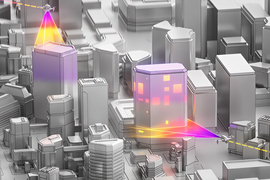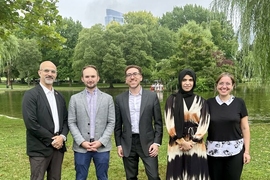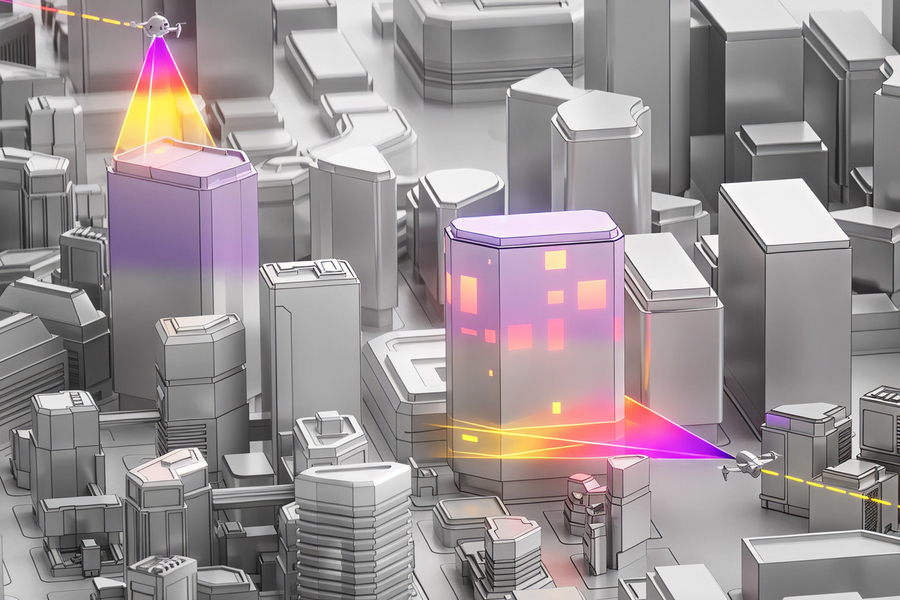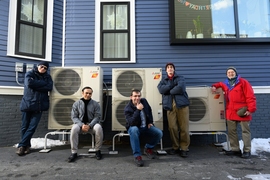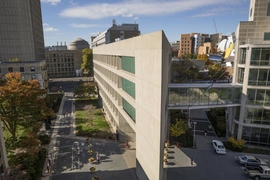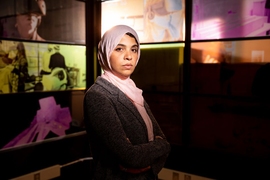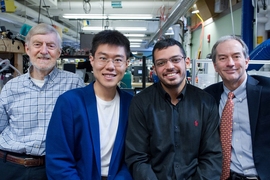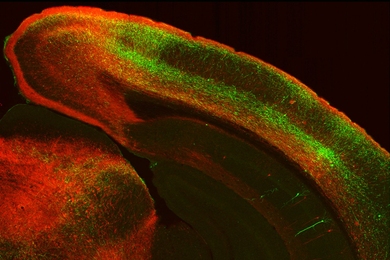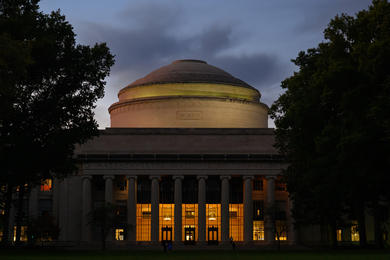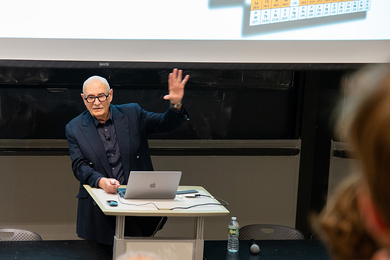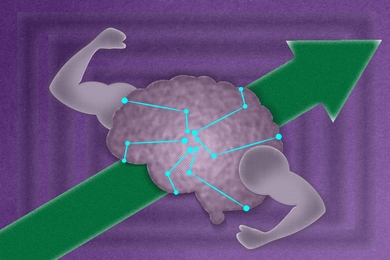Audio
Older buildings let thousands of dollars-worth of energy go to waste each year through leaky roofs, old windows, and insufficient insulation. But even as building owners face mounting pressure to comply with stricter energy codes, making smart decisions about how to invest in efficiency is a major challenge.
Lamarr.AI, born in part from MIT research, is making the process of finding ways to improve the energy efficiency of buildings as easy as clicking a button. When customers order a building review, it triggers a coordinated symphony of drones, thermal and visible-range cameras, and artificial intelligence designed to identify problems and quantify the impact of potential upgrades. Lamarr.AI’s technology also assesses structural conditions, creates detailed 3D models of buildings, and recommends retrofits. The solution is already being used by leading organizations across facilities management as well as by architecture, engineering, and construction firms.
“We identify the root cause of the anomalies we find,” says CEO and co-founder Tarek Rakha PhD ’15. “Our platform doesn’t just say, ‘This is a hot spot and this is a cold spot.’ It specifies ‘This is infiltration or exfiltration. This is missing insulation. This is water intrusion.’ The detected anomalies are also mapped to a 3D model of the building, and there are deeper analytics, such as the cost of each retrofit and the return on investment.”
To date, the company estimates its platform has helped clients across health care, higher education, and multifamily housing avoid over $3 million in unnecessary construction and retrofit costs by recommending targeted interventions over costly full-system replacements, while improving energy performance and extending asset life. For building owners managing portfolios worth hundreds of millions of dollars, Lamarr.AI’s approach represents a fundamental shift from reactive maintenance to strategic asset management.
The founders, who also include MIT Professor John Fernández and Research Scientist Norhan Bayomi SM ’17, PhD ’21, are thrilled to see their technology accelerating the transition to more energy-efficient and higher-performing buildings.
“Reducing carbon emissions in buildings gets you the greatest return on investment in terms of climate interventions, but what has been needed are the technologies and tools to help the real estate and construction sectors make the right decisions in a timely and economical way,” Fernández says.
Automating building scans
Bayomi and Rakha completed their PhDs in the MIT Department of Architecture’s Building Technology Program. For her thesis, Bayomi developed technology to detect features of building exteriors and classify thermal anomalies through scans of buildings, with a specific focus on the impact of heat waves on low-income communities. Bayomi and her collaborators eventually deployed the system to detect air leaks as part of a partnership with a community in New York City.
After graduating MIT, Rakha became an assistant professor at Syracuse University. In 2015, together with fellow Syracuse University Professor Senem Velipasalar, he began developing his concept for drone-based building analytics — an idea that later received support through a grant from New York State’s Department of Economic Development. In 2019, Bayomi and Fernández joined the project, and the team received a $1.8 million research award from the U.S. Department of Energy.
“The technology is like giving a building an MRI using drones, infrared imaging, visible light imaging, and proprietary AI that we developed through computer vision technology, along with large language models for report generation,” Rakha explains.
“When we started the research, we saw firsthand how vulnerable communities were suffering from inefficient buildings, but couldn’t afford comprehensive diagnostics,” Bayomi says. “We knew that if we could automate this process and reduce costs while improving accuracy, we’d unlock a massive market. Now we’re seeing demand from everyone, from municipal buildings to major institutional portfolios.”
Lamarr.AI was officially founded in 2021 to commercialize the technology, and the founders wasted no time tapping into MIT’s entrepreneurial ecosystem. First, they received a small seed grant from the MIT Sandbox Innovation Fund. In 2022, they won the MITdesignX prize and were semifinalists in the MIT $100K Entrepreneurship Competition. The founders named the company after Hedy Lamarr, the famous actress and inventor of a patented technology that became the basis for many modern secure communications.
Current methods for detecting air leaks in buildings utilize fan pressurizers or smoke. Contractors or building engineers may also spot-check buildings with handheld infrared cameras to manually identify temperature differences across individual walls, windows, and ductwork.
Lamarr.AI’s system can perform building inspections far more quickly. Building managers can order the company’s scans online and select when they’d like the drone to fly. Lamarr.AI partners with drone companies worldwide to fly off-the-shelf drones around buildings, providing them with flight plans and specifications for success. Images are then uploaded onto Lamarr.AI’s platform for automated analysis.
“As an example, a survey of a 180,000-square-foot building like the MIT Schwarzman College of Computing, which we scanned, produces around 2,000 images,” Fernández says. “For someone to go through those manually would take a couple of weeks. Our models autonomously analyze those images in a few seconds.”
After the analysis, Lamarr.AI’s platform generates a report that includes the suspected root cause of every weak point found, an estimated cost to correct that problem, and its estimated return on investment using advanced building energy simulations.
“We knew if we were able to quickly, inexpensively, and accurately survey the thermal envelope of buildings and understand their performance, we would be addressing a huge need in the real estate, building construction, and built environment sectors,” Fernández explains. “Thermal anomalies are a huge cause of unwanted heat loss, and more than 45 percent of construction defects are tied to envelope failures.”
The ability to operate at scale is especially attractive to building owners and operators, who often manage large portfolios of buildings across multiple campuses.
“We see Lamarr.AI becoming the premier solution for building portfolio diagnostics and prognosis across the globe, where every building can be equipped not just for the climate crisis, but also to minimize energy losses and be more efficient, safer, and sustainable,” Rakha says.
Building science for everyone
Lamarr.AI has worked with building operators across the U.S. as well as in Canada, the United Kingdom, and the United Arab Emirates.
In June, Lamarr.AI partnered with the City of Detroit, with support from Newlab and Michigan Central, to inspect three municipal buildings to identify areas for improvement. Across two of the buildings, the system identified more than 460 problems like insulation gaps and water leaks. The findings were presented in a report that also utilized energy simulations to demonstrate that upgrades, such as window replacements and targeted weatherization, could reduce HVAC energy use by up to 22 percent.
The entire process took a few days. The founders note that it was the first building inspection drone flight to utilize an off-site operator, an approach that further enhances the scalability of their platform. It also helps further reduce costs, which could make building scans available to a broader swath of people around the world.
“We’re democratizing access to very high-value building science expertise that previously cost tens of thousands per audit,” Bayomi says. “Our platform makes advanced diagnostics affordable enough for routine use, not just one-time assessments. The bigger vision is automated, regular building health monitoring that keeps facilities teams informed in real-time, enabling proactive decisions rather than reactive crisis management. When building intelligence becomes continuous and accessible, operators can optimize performance systematically rather than waiting for problems to emerge.”
